Panasonic AV-HS450N User Manual
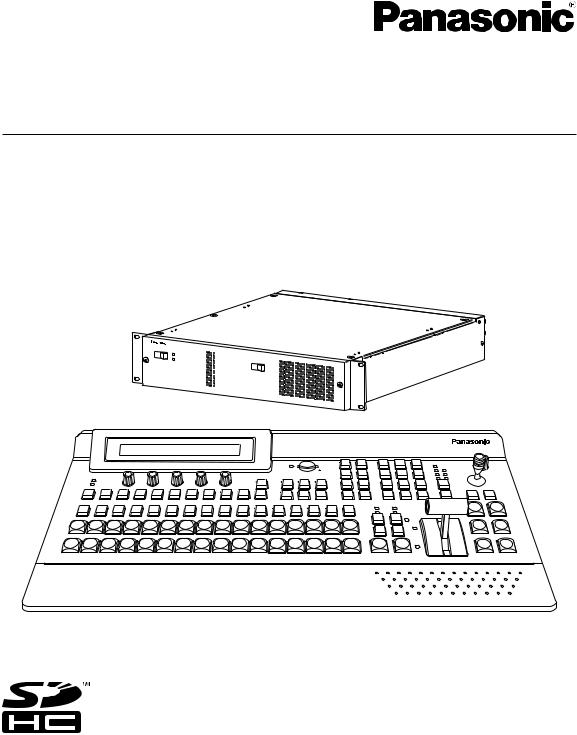
Operating Instructions
Multi-format Live Switcher
Model No. AV-HS450N
Mainframe
[AV-HS450U1N]
POWER
ALARM
OFF |
POWER1 |
ON |
POWER1 |
|
|
ALARM1 |
POWER2 |
|
|
OFF |
ON |
 POWER2
POWER2
 ALARM2
ALARM2
Multi-format |
|
Live Switcher |
AV-HS450 |
Multi-format Live Switcher AV-HS450
Control panel [AV-HS450C1N]
Before operating this product, please read the instructions carefully and save this manual for future use.
Printed in Japan |
3TR006327AAC |
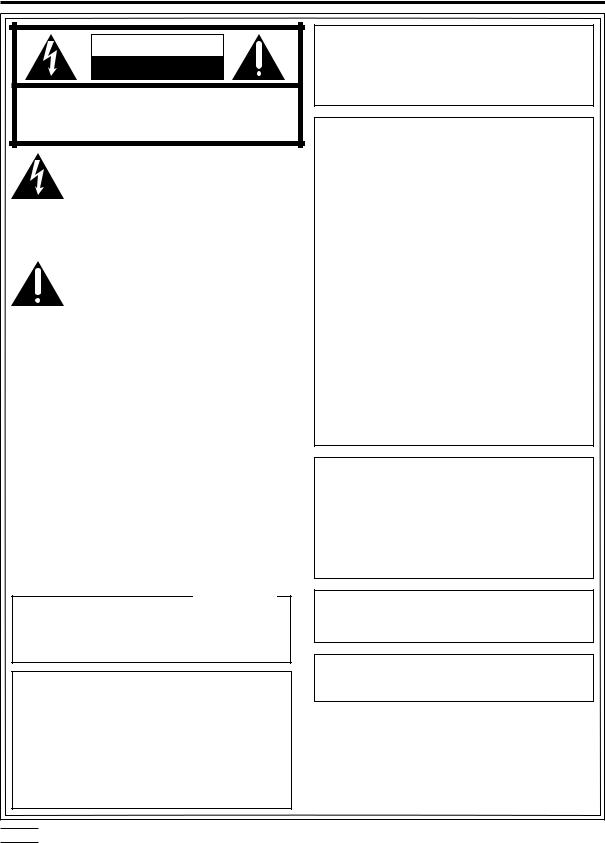
Safety precautions
CAUTION
RISK OF ELECTRIC SHOCK
DO NOT OPEN
CAUTION: TO REDUCE THE RISK OF ELECTRIC SHOCK,
DO NOT REMOVE COVER (OR BACK).
NO USER SERVICEABLE PARTS INSIDE.
REFER TO SERVICING TO QUALIFIED SERVICE PERSONNEL.
The lightning flash with arrowhead symbol, within an equilateral triangle, is intended to alert the user to the presence of uninsulated “dangerous voltage” within the product’s enclosure that may be of sufficient magnitude to constitute a risk of electric shock to persons.
The exclamation point within an equilateral triangle is intended to alert the user to the presence of important operating and maintenance (service) instructions in the literature accompanying the appliance.
WARNING:
THIS APPARATUS MUST BE EARTHED
To ensure safe operation, the three-pin plug must be inserted only into a standard three-pin power point which is effectively earthed through the normal household wiring.
Extension cords used with the apparatus must have three cores and be correctly wired to provide connection to the earth. Wrongly wired extension cords are a major cause of fatalities.
The fact that the apparatus operates satisfactorily does not imply that the power point is earthed or that the installation is completely safe. For your safety, if you are in any doubt about the effective earthing of the power point, please consult a qualified electrician.
For CANADA
This class A digital apparatus complies with Canadian ICES-003.
Cet appareil numérique de la classe A est conforme à la norme NMB-003 du Canada.
WARNING:
•TO REDUCE THE RISK OF FIRE OR ELECTRIC SHOCK, DO NOT EXPOSE THIS APPARATUS TO RAIN OR MOISTURE.
•THE APPARATUS SHALL NOT BE EXPOSED TO DRIPPING OR SPLASHING AND THAT NO OBJECTS FILLED WITH LIQUIDS, SUCH AS VASES, SHALL BE PLACED ON THE APPARATUS.
CAUTION:
TO REDUCE THE RISK OF FIRE OR SHOCK HAZARD AND ANNOYING INTERFERENCE, USE THE RECOMMENDED ACCESSORIES ONLY.
FCC Note:
This equipment has been tested and found to comply with the limits for a class A digital device, pursuant to Part 15 of the FCC Rules. These limits are designed to provide reasonable protection against harmful interference when the equipment is operated in a commercial environment. This equipment generates, uses, and can radiate radio frequency energy, and if not installed and used in accordance with the instruction manual, may cause harmful interference to radio communications. Operation of this equipment in a residential area is likely to cause harmful interference in which case the user will be required to correct the interference at his own expense.
Warning:
To assure continued FCC emission limit compliance, the user must use only shielded interface cables when connecting to external units. Also, any unauthorized changes or modifications to this equipment could void the user’s authority to operate it.
CAUTION:
In order to maintain adequate ventilation, do not install or place this unit in a bookcase, built-in cabinet or any other confined space. To prevent risk of electric shock or fire hazard due to overheating, ensure that curtains and any other materials do not obstruct the ventilation.
The socket outlet shall be installed near the equipment and easily accessible or the mains plug or a power switch shall remain readily operable.
A warning that an apparatus with CLASS I construction shall be connected to a MAINS socket outlet with a protective earthing connection.


 indicates safety information.
indicates safety information.
2

Safety precautions
IMPORTANT SAFETY INSTRUCTIONS
Read these operating instructions carefully before using the unit. Follow the safety instructions on the unit and the applicable safety instructions listed below. Keep these operating instructions handy for future reference.
1)Read these instructions.
2)Keep these instructions.
3)Heed all warnings.
4)Follow all instructions.
5)Do not use this apparatus near water.
6)Clean only with dry cloth.
7)Do not block any ventilation openings. Install in accordance with the manufacturer’s instructions.
8) Do not |
install near any heat sources |
such as |
radiators, heat registers, stoves, or |
other apparatus (including amplifiers) that produce heat.
9)Do not defeat the safety purpose of the polarized or grounding-type plug. A polarized plug has two blades with one wider than the other. A grounding-type plug has two blades and a third grounding prong. The wide blade or the third prong are provided for your safety. If the provided plug does not fit into your outlet, consult an electrician for replacement of the obsolete outlet.
10)Protect the power cord form being walked on or pinched particularly at plugs, convenience receptacles, and the point where they exit from the apparatus.
11)Only use attachments/accessories specified by the manufacturer.
12)Use only with the cart, stand,
tripod, bracket, or table specified by the manufacturer, or sold with the apparatus. When a cart is used, use caution when moving the cart/apparatus combination to avoid injury from tip-over.
13)Unplug this apparatus during lightning storms or when unused for long periods of time.
14)Refer all servicing to qualified service personnel. Servicing is required when the apparatus has been damaged in any way, such as power-supply cord or plug is damaged, liquid has been spilled or objects have fallen into the apparatus, the apparatus has been exposed to rain or moisture, does not operate normally, or has been dropped.


 indicates safety information.
indicates safety information.
<For USA-California Only>
This product contains a CR Coin Cell Lithium Battery which contains Perchlorate Material – special handling may apply.
See www.dtsc.ca/gov/hazardouswaste.perchlorate.
3

Contents
Description................................................ |
7 |
Features..................................................... |
7 |
Configuration............................................ |
9 |
Accessories .............................................. |
9 |
Precautions for use ................................ |
10 |
Trademarks and |
|
Registered Trademarks..................... |
11 |
Disclaimer of Warranty........................... |
11 |
1. Installation........................................... |
12 |
1-1. Installing the control panel............................... |
12 |
1-2. Installing the mainframe .................................. |
13 |
1-3. How to install the option boards ...................... |
14 |
1-4. Connections .................................................... |
16 |
1-4-1. Block diagram ........................................... |
16 |
1-4-2. Connections when implementing gen-lock |
|
(frame synchronizer OFF) .................... |
17 |
1-4-3. Connections when not implementing gen- |
|
lock (frame synchronizer ON) .............. |
18 |
2. Functions in each area....................... |
19 |
2-1. Control panel................................................... |
19 |
2-1-1. Crosspoint area ........................................ |
20 |
2-1-2. Wipe pattern/memory area ....................... |
21 |
2-1-3. User button area ....................................... |
22 |
2-1-4. Transition area .......................................... |
22 |
2-1-5. LCD menu area ........................................ |
25 |
2-1-6. Positioner area.......................................... |
27 |
2-1-7. SD memory card area .............................. |
28 |
2-1-8. Rear panel connections area.................... |
29 |
2-2. Mainframe ....................................................... |
30 |
2-2-1. Front panel................................................ |
30 |
2-2-2. Rear panel connections area.................... |
31 |
3. Basic operations................................. |
33 |
3-1. Background transition...................................... |
33 |
3-1-1. Selecting the bus ...................................... |
33 |
3-1-2. Selecting the bus using the |
|
SHIFT function ..................................... |
33 |
3-1-3. Selecting the bus mode ............................ |
36 |
3-1-4. Selecting the transition mode ................... |
37 |
3-1-5. Manual transition (using the fader lever)... |
37 |
3-1-6. Auto transition........................................... |
37 |
3-1-7. Cut transition............................................. |
37 |
3-2. IMAGE............................................................. |
38 |
3-2-1. Setting the IMAGE effects......................... |
38 |
3-2-2. Executing the IMAGE effect...................... |
39 |
3-3. Wipe ................................................................ |
40 |
3-3-1. Selecting the wipe pattern ........................ |
40 |
3-3-2. Selecting the background for the |
|
3D2 pattern page ................................. |
42 |
3-3-3. Selecting the wipe direction...................... |
42 |
3-3-4. Wipe decorations (border, soft effect) ....... |
43 |
3-3-5. Setting the wipe start position................... |
44 |
3-3-6. Modifying wipe.......................................... |
45 |
3-4. Key .................................................................. |
47 |
3-4-1. Selecting the key type............................... |
48 |
3-4-2. Selecting the key material......................... |
49 |
3-4-3. Key transitions .......................................... |
50 |
3-4-4. Key preview............................................... |
51 |
3-4-5. Adjusting the luminance key |
|
and linear key ....................................... |
52 |
3-4-6. Adjusting the chroma key ......................... |
53 |
3-4-7. Key decorations ........................................ |
61 |
3-4-8. Masking the key signals............................ |
62 |
3-4-9. Flying key.................................................. |
63 |
3-5. PinP (picture in picture)................................... |
64 |
3-5-1. Selecting the PinP channel |
|
and material ......................................... |
64 |
3-5-2. Selecting Shape........................................ |
65 |
3-5-3. PinP preview............................................. |
65 |
3-5-4. PinP transitions......................................... |
66 |
3-5-5. PinP adjustments...................................... |
66 |
3-5-6. Linking PinP1 and PinP2 .......................... |
68 |
3-5-7. PinP decorations....................................... |
69 |
3-5-8. Trimming settings...................................... |
70 |
4

Contents
3-6. DSK (downstream key).................................... |
71 |
3-6-1. Selecting the DSK type............................. |
71 |
3-6-2. Selecting the DSK channel and |
|
DSK fill material.................................... |
73 |
3-6-3. DSK transitions......................................... |
74 |
3-6-4. DSK preview ............................................. |
74 |
3-6-5. DSK adjustments...................................... |
75 |
3-6-6. DSK decorations....................................... |
76 |
3-6-7. Masking the DSK signals.......................... |
77 |
3-7. FTB (fade to black) .......................................... |
78 |
3-8. Internal color signals ....................................... |
79 |
3-8-1. Setting the color background .................... |
79 |
3-9. Switching the AUX output................................ |
80 |
3-9-1. Selecting the AUX output materials .......... |
80 |
3-9-2. AUX1 transitions ....................................... |
81 |
3-9-3. Setting enable/disable for the |
|
AUX1 transition..................................... |
82 |
3-10. Memory ......................................................... |
83 |
3-10-1. Memory registration and recall items...... |
84 |
3-10-2. Storing the settings in the |
|
memory (Store) ................................... |
85 |
3-10-3. Recalling the operations stored in the |
|
memory (Recall)................................... |
86 |
3-10-4. Deleting the operations stored in the |
|
memory (Delete) .................................. |
87 |
3-10-5. Effect dissolve......................................... |
88 |
3-11. Frame memories ........................................... |
89 |
3-11-1. Transferring images from the AUX bus ... |
89 |
3-11-2. Saving Images in Flash Memory ............ |
90 |
3-12. SD memory cards ......................................... |
91 |
3-12-1. Initializing the SD memory cards ............ |
92 |
3-12-2. Saving data on SD memory cards.......... |
93 |
3-12-3. Loading data from SD memory cards..... |
94 |
3-12-4. Deleting files on SD memory cards ........ |
95 |
3-12-5. Displaying the SD memory card |
|
information........................................... |
95 |
4. Input/output signal settings............... |
96 |
4-1. Input signal settings......................................... |
96 |
4-1-1. Setting the frame synchronizer ................. |
97 |
4-1-2. Setting the input mode.............................. |
98 |
4-1-3. Freezing the input signals......................... |
99 |
4-1-4. Color corrector........................................ |
100 |
4-1-5. Setting the up-converter ......................... |
104 |
4-1-6. Setting the analog input gain (option)..... |
105 |
4-1-7. Setting the analog composite input signals |
|
(option) ............................................... |
106 |
4-2. Setting the DVI input signals (option) ............ |
107 |
4-2-1. Setting the DVI input signals................... |
107 |
4-2-2. Adjusting the DVI input signals ............... |
111 |
4-3. Setting the output signals.............................. |
112 |
4-3-1. Assigning the output signals................... |
113 |
4-4. Setting the DVI output signals |
|
(OUT5 and OUT6 standard outputs and |
|
options) ..................................................... |
115 |
4-5. Setting the down-converter (option) .............. |
117 |
4-6. Setting the sync signals................................. |
118 |
4-7. Adjusting the output signal phase ................. |
119 |
4-8. Setting the multi view display ........................ |
123 |
4-8-1. Setting the screen layout ........................ |
123 |
4-8-2. Setting the split frame and characters .... |
125 |
4-8-3. Setting the tally displays ......................... |
126 |
4-8-4. Changing the material names................. |
127 |
4-8-5. High-resolution multi view mode............. |
128 |
4-9. Setting the on-screen display (OSD)............. |
129 |
4-10. Setting the ancillary data............................. |
130 |
5

Contents
5. System settings ................................ |
131 |
5-1. Selecting the video format............................. |
131 |
5-2. Setting the crosspoints.................................. |
132 |
5-2-1. Assigning signals to the crosspoints....... |
132 |
5-2-2. Setting the crosspoint switching ............. |
134 |
5-3. Button assignments....................................... |
135 |
5-3-1. Setting the user buttons.......................... |
135 |
5-4. Setting the date and time .............................. |
137 |
5-5. Network settings............................................ |
138 |
5-6. Other settings................................................ |
139 |
5-7. External device control.................................. |
140 |
5-7-1. Enable/Disable Setting for Control of |
|
External Devices ................................ |
140 |
5-7-2. Editor control........................................... |
141 |
5-7-3. Setting the GPI ....................................... |
142 |
5-7-4. Camera control ....................................... |
144 |
5-8. Status displays .............................................. |
151 |
5-8-1. Alarm status displays.............................. |
151 |
5-8-2. Alarm message....................................... |
151 |
5-8-3. Displaying the version information and |
|
option information................................ |
152 |
5-9. Initialization.................................................... |
153 |
5-9-1. Initializing Setting Data ........................... |
153 |
5-9-2. Initializing Fader...................................... |
153 |
6. External interfaces ........................... |
154 |
6-1. Connecting the control panel |
|
and mainframe.......................................... |
154 |
6-2. Mainframe ..................................................... |
154 |
6-2-1. LAN......................................................... |
154 |
6-2-2. EDITOR .................................................. |
155 |
6-2-3. COM ....................................................... |
155 |
6-2-4. TALLY/GPI............................................... |
156 |
6-3. Control panel................................................. |
157 |
6-3-1. TALLY/GPI............................................... |
157 |
7. Image transmission functions......... |
158 |
8. Setting menu table............................ |
163 |
9. Appearance ....................................... |
181 |
10. Specifications ................................. |
182 |
Appendix (glossary)............................. |
187 |
6

Description
This is a 1 ME digital video switcher which supports a multiple number of HD and SD formats. It consists of a mainframe and control panel.
Despite its compact dimensions of 2RU, the mainframe comes with 16 inputs and four outputs for SDI under the standard specifications.
It also supports two DVI outputs, and its video effects of one key line, two DSK lines, two PinP lines, two DVE (BKGD) lines, one DVE (key) line and two multi view lines enable video productions in a wide variety of forms. Incorporated in the switcher’s inputs are a frame synchronizer, up-converter and color corrector.
When the option boards are installed, a wider variety of input/output formats including analog composite, analog component and DVI can be accommodated so that systems can be constructed flexibly.
Features
Compact design, wide variety of input/output signals
The mainframe, despite its compact dimensions of 2RU, comes with a wide variety of input/output facilities in the standard configuration.
As input facilities, a total of 16 HD/SD-SDI signal lines are supported under the standard specifications, and a frame synchronizer is incorporated for all the inputs. Also incorporated are four up-converter signal lines and eight color corrector signal lines.
The output facilities include four HD/SD-SDI signal lines and two DVI-D signal lines under the standard specifications.
Two option slots each for input/output applications are provided.
When two option boards for input applications are installed, the maximum number of input signal lines can be expanded to 20; similarly, when two option boards for output applications are installed, the maximum number of output signal lines can be increased to 10.
Multiple formats supported
The signal formats supported include HD formats (1080/59.94i, 1080/50i, 1080/24PsF 1, 1080/23.98PsF 1, 720/59.94p and 720/50p), SD formats (480/59.94i and 576/50i) and DVI 2.
1: The following option boards are not supported:
AV-HS04M1, AV-HS04M2, AV-HS04M3, AV-HS04M4, AV-HS04M5,
AV-HS04M6, AV-HS04M7
2: The standard DVI output is the DVI-D signal output.
The AV-HS04M3 option board supports DVI-I signal input, the AV-HS04M8 option board supports DVI-D signal input, and the AV-HS04M5 supports DVI-I signal output.
Multi view display function
Two multi view display function lines are provided under the standard specifications.
It is possible to divide up to 20 lines of video including program video (PGM), preview video (PVW) and input video signals between two screens and display them at the same time on two monitors.
Frame synchronizer system and external synchronization system supported
A high-performance 10-bit frame synchronizer is incorporated for all the inputs so that asynchronous video signals can be input. By using the black burst (BB) output, it is possible to construct a system referenced to the synchronization of the switcher.
A genlock function is provided so that external synchronization systems using external sync signals (BB or TRI signals) as a reference are also supported.
7

Features
Many different effect functions incorporated
Along with the standard wipe, mix and cut functions, the switcher can provide size reduction, slide and other DVE transitions.
DVE transitions using the 2-screen push-out effect and other 2-channel functions are possible.
The unit comes with luminance keys and chroma keys provided as keyers as well as specialized hardware in the form of two DSK lines and two PinP lines as a standard option.
AUX1 is equipped with a mix transition function.
This enables MIX transitions with the material selected next, allowing for a flexible system construction.
High-quality chroma keys using Primatte® algorithms
The Primatte® algorithm, which has proven to be very popular in many non-linear editors as a plug-in software, has been put to practical use in a linear editing system for the chroma keys. High chroma key image quality can be achieved through some simple operations.
Primatte® is a registered trademark of IMAGICA DIGIX Inc.
The copyrights of Primatte® belong to IMAGICA DIGIX Inc.
The patents for Primatte® belong to IMAGICA DIGIX Inc.
SDHC memory cards supported
Still image data (BMP, JPEG) can be imported from SDHC memory cards into the unit’s frame memories for use as background images or key materials.
In addition, the images and setting data in the unit’s frame memories can be stored on the SDHC memory cards.
SDHC Logo is a trademark.
Pan-tilt head system (pan-tilt head and convertible camera) control supported
Using the COM connector, a Panasonic pan-tilt head system (with pan, tilt, zoom, focus and preset functions) can be controlled.
When a controller is used, up to five pan-tilt head systems can be controlled. Camera menu operations can also be performed.
Controllers supported |
AW-RP555N, AW-RP655N |
|
|
Pan-tilt heads supported |
AW-PH400P, AW-PH405N, AW-PH360N |
|
|
Camera supported |
AW-HE100N |
|
|
Redundant power supply
Under the standard specifications, a redundant power supply is provided so that live operations can be undertaken with complete peace of mind.
Simple operability
Live transmissions can be delivered speedily thanks to the 16 crosspoint buttons and pattern selection buttons and other controls on the panel with its simple layout that enables various functions to be operated directly. Preset-like operations are performed using menus appearing on the unit’s LCD display or on the on-screen displays.
8

Configuration |
|
|
|
Mainframe [AV-HS450U1N] .............................................................................. |
|
|
1 |
Control panel [AV-HS450C1N] .......................................................................... |
|
|
1 |
Accessories |
|
|
|
Operating instructions ....................................................................................... |
|
|
1 |
CD-ROM (Operating instructions/Image transmission software) ...................... |
1 |
||
AC adapters (for control panel) ......................................................................... |
|
|
2 |
Power cords (for mainframe and AC adapter) .................................................. |
|
4 |
|
CAT5E cable (STP, straight cable, 10 m long) .................................................. |
|
1 |
|
Optional boards (sold separately) |
|
|
|
Board |
Model number |
|
Function |
SDI Input Board |
AV-HS04M1 |
SDI input 2 lines |
|
Analog Input Board |
AV-HS04M2 |
Analog component input 2 lines |
|
DVI Input Board |
AV-HS04M3 |
DVI-I input 2 lines |
|
Analog Output Board |
AV-HS04M4 |
Analog component output 2 lines |
|
DVI/Analog Output Board |
AV-HS04M5 |
DVI-I output 1 line |
|
|
|
Analog component output 1 line |
|
Analog Composite Input Board |
AV-HS04M6 |
Analog composite input 2 lines |
|
SDI Output Board |
AV-HS04M7 |
SDI output 2 lines |
|
Full-HD DVI Input Board |
AV-HS04M8 |
DVI-D input 2 line |
|
Option boards are installed in the two input/output option slots (slot A, slot B).
9

Precautions for use
Handle carefully.
Do not drop the product, or subject it to strong shock or vibration.
Do not carry or move the product by the fader lever. This is important to prevent trouble.
Use the product in an ambient temperature of 32 °F to 104 °F (0 °C to 40 °C).
Avoid using the product at a cold place below 32 °F (0 °C) or at a hot place above 104 °F (40 °C) because extremely low or high temperature will adversely affect the parts inside.
Power off before connecting or disconnecting cables.
Before plugging or unplugging the cables, be sure to switch power off.
Avoid humidity and dust.
Avoid using the product at a humid, dusty place because much humidity and dust will cause damage to the parts inside.
Maintenance
Wipe the product using a dry cloth. To remove stubborn dirt, dip a cloth into a diluted solution of kitchen detergent (neutral), wring it out well, and wipe the product gently. Then, after wiping the product with a moist cloth, wipe it again with a dry cloth.
Caution
•Avoid using benzine, paint thinners and other volatile fluids.
•If a chemical cleaning cloth is to be used, carefully read through the precautions for its use.
Precaution to be observed during production
This product’s image switching and image effect functions can be used to produce images which flicker rapidly or images which change rapidly.
However, bear in mind when using these functions in production that the kinds of images produced may have an adverse effect on the viewer’s physical well-being.
Handling the optional boards
Be absolutely sure to turn off the power of the product before installing or removing any of the optional boards. Furthermore, when installing or removing the optional boards, take care not to hurt yourself on the edges and metal parts of the boards.
When the product is to be discarded
When the product is to be discarded at the end of its service life, ask a specialized contractor to dispose of it properly in order to protect the environment.
Concerning the consumable parts
Cooling fan:
This is a consumable part. As a general rule, replace it every 5 years or so (when the unit has been operated for 15 hours a day).
Power supply unit:
This is a consumable part. As a general rule, replace it every 5 years or so (when the unit has been operated for 15 hours a day).
The period when the consumable parts need to be replaced will differ depending on the operating conditions.
When the time comes to replace one of these parts, be absolutely sure to ask your dealer to do the job.
10

Precautions for use
Trademarks and Registered Trademarks
Microsoft and Windows are either registered trademarks or trademarks of Microsoft Corporation in the United States and other countries.
Adobe and Reader are either registered trademarks or trademarks of Adobe Systems Incorporated in the United States and/or other countries.
SDHC logo is a trademark.
Other names of companies and products contained in these operating instructions may be trademarks or registered trademarks of their respective owners.
Disclaimer of Warranty
IN NO EVENT SHALL Panasonic Corporation BE LIABLE TO ANY PARTY OR ANY PERSON, EXCEPT FOR REPLACEMENT OR REASONABLE MAINTENANCE OF THE PRODUCT, FOR THE CASES, INCLUDING BUT NOT LIMITED TO BELOW:
ANY DAMAGE AND LOSS, INCLUDING WITHOUT LIMITATION, DIRECT OR INDIRECT, SPECIAL, CONSEQUENTIAL OR EXEMPLARY, ARISING OUT OF OR RELATING TO THE PRODUCT;
PERSONAL INJURY OR ANY DAMAGE CAUSED BY INAPPROPRIATE USE OR NEGLIGENT OPERATION OF THE USER;
UNAUTHORIZED DISASSEMBLE, REPAIR OR MODIFICATION OF THE PRODUCT BY THE USER;
INCONVENIENCE OR ANY LOSS ARISING WHEN IMAGES ARE NOT DISPLAYED, DUE TO ANY REASON OR CAUSE INCLUDING ANY FAILURE OR PROBLEM OF THE PRODUCT;
ANY PROBLEM, CONSEQUENTIAL INCONVENIENCE, OR LOSS OR DAMAGE, ARISING OUT OF THE SYSTEM COMBINED BY THE DEVICES OF THIRD PARTY;
INCONVENIENCE, DAMAGE, OR LOSS RESULTING FROM ACCIDENTS CAUSED BY AN INADEQUATE INSTALLATION METHOD OR ANYTHING OTHER THAN A DEFECT IN THE PRODUCT;
LOSS OF REGISTERED DATA CAUSED BY ANY FAILURE.
ANY DAMAGE OR CLAIMS DUE TO LOSS OR LEAKAGE OF IMAGE DATA OR SETTING DATA SAVED ON THIS UNIT OR ON AN SD CARD OR PC.
11

1. Installation
1-1. Installing the control panel
Follow the instructions set forth in “Safety precautions” and also observe the cautionary items below.
Be absolutely sure to ask your dealer to do the jobs of installing and connecting the panel.
Connecting the power supply
Be absolutely sure to use only the power cord and AC adapter supplied with the panel.
Be absolutely sure to connect the grounding terminal of the power cord to ground.
Also connect the ground terminal (SIGNAL GND) at the rear of the panel to the system ground.
If only one AC adapter is to be connected, place the dust-proof cap over the DC power input socket that is not going to be used.
To prevent the DC plug from being disconnected, secure the cable of the AC adapter to the cable clamp.
When the control panel is not going to be used for a prolonged period of time, set its power switch to the “off” position to conserve power, and disconnect the power plug.
Dust-proof cap
POWER
OFF
IN2 |
ON |
LCD CONTRAST |
IN112V |
12V |
MAINFRAME
Cable clamp
Handle the control panel carefully!
Dropping the control panel or subjecting it to strong impact or vibration may cause trouble and/or malfunctioning.
Do not allow any foreign objects to enter inside the control panel!
Allowing water, metal items, scraps of food or other foreign objects inside the control panel may cause a fire and/or electric shocks.
Choosing the best installation location
This unit is designed for indoor use only.
Install the unit on a sufficiently strong, stable and level surface for use.
Ensure a space of at least 100 mm around the rear vents to avoid obstructing ventilation.
In particular, ensure sufficient space between ventilation and wiring when using mounted in a panel or table.
Do not install the panel in a cold place where the temperatures will drop below 32 °F (0 °C) or in a hot place where the temperatures will rise above 104 °F (40 °C).
Avoid installing the panel where it will be exposed to direct sunlight or to the hot air that is blown out from other products.
Installing the panel in a very humid, dusty or vibrationprone location may give rise to trouble.
Ventilation holes
Multi-format Live Switcher AV-HS450
12

1. Installation
1-2. Installing the mainframe
Comply with the instructions set forth in “Safety precautions” and also observe the cautionary items below.
Be absolutely sure to ask your dealer to do the jobs of installing and connecting the mainframe.
Connecting the power supply
Be absolutely sure to use the power cord supplied with the mainframe.
Be absolutely sure to connect the grounding terminal of the power cord to ground.
Handle the mainframe carefully!
Dropping the mainframe or subjecting it to strong impact or vibration may cause trouble and/or malfunctioning.
Do not allow any foreign objects to enter inside the mainframe!
Allowing water, metal items, scraps of food or other foreign objects inside the control panel may cause a fire and/or electric shocks.
Choosing the best installation location
This unit is designed for indoor use only.
Mount the mainframe securely in a standard 19-inch rack (with a depth dimension of at least 600 mm) that meets the EIA standard or its equivalent for use.
Install the mainframe securely using screws that are compatible with the rack.
Be absolutely sure to attach the support guides used to support the back part of the mainframe. (Provide support guides that are compatible with the rack.)
Provide sufficient clearances from the area around the ventilation holes at the front and the cooling fan at the back.
Do not install the mainframe in a cold place where the temperatures will drop below 32 °F (0 °C) or in a hot place where the temperatures will rise above 104 °F (40 °C).
Avoid installing the mainframe where it will be exposed to direct sunlight or to the hot air that is blown out from other products.
Installing the mainframe in a very humid, dusty or vibration-prone location may give rise to trouble.
Support guides
OFFPOWER1
ON
 POWER1
POWER1
ALARM1 OFFPOWER2
ON
 POWER2
POWER2
ALARM2
Multi-format Live Switcher AV-HS450







 -HS450
-HS450 



 AV
AV




 Live
Live
-format
Multi
Switcher
Installation in a rack |
Flow of air through the ventilation holes |
13

1. Installation
1-3. How to install the option boards
The option boards are installed in the mainframe.
For details, refer to the operating instructions of the option board concerned.
Notes
Be absolutely sure to ask your dealer to do the job of installing or removing the option boards.
Before installing or removing an option board, turn off the power, and disconnect the power plug.
Before coming into physical contact with the option board, touch your hand to metal that has been grounded to discharge the static electricity in your body.
A safe way to proceed is to wear an anti-static wrist strap.
The option board may be damaged if you touch the board with static still in your body.
Avoid damage to the option board by not dropping it or subjecting it to strong shocks or vibrations.
After removing an option board, be absolutely sure to attach the blank panel.
When installing or removing an option board, take care not to hurt yourself on the edges or metal parts of the board.
Turn off the power of the mainframe, and disconnect the power cord.
Loosen the two screws of SLOT A or SLOT B at the back of the mainframe, and remove the blank panel.
SLOT A
SLOT B
 Blank panel
Blank panel
Screw
Screw
14
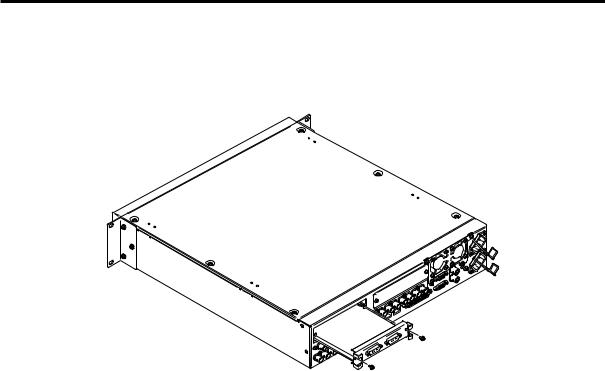
1. Installation
Align the option board with the guide rails, and insert it slowly.
Insert it until it will go no further. Take care not to exert excessive force while doing this since that may damage the connector inside.
Mount the option board in place using the two screws.
Clamping torque: 0.7 N•m
-D DVI
UTS
INP
DVI
-D DVI
Screw
Screw
After connecting the necessary cables, plug the power cord into the power outlet, and turn on the power.
15
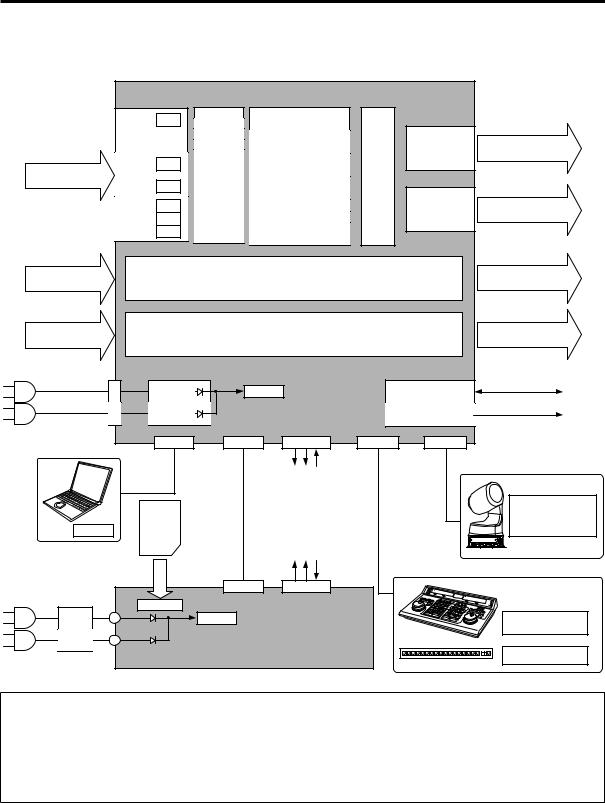
1. Installation
1-4. Connections
1-4-1. Block diagram
|
Mainframe |
|
|
|
|
|
|
|
|
|
FS |
Black |
|
BKGD |
|
|
|
|
INPUT |
ColorBGD |
CUT, MIX, WIPE, DVE 2 |
|
|
|
||
|
|
|
|
|
||||
|
1 to 8 |
|
ColorBar |
|
KEY |
|
OUTPUT |
OUTPUT (SDI) |
|
|
|
FMEM1 to 4 |
|
CUT, MIX, WIPE, DVE |
|
||
|
|
|
|
|
PinP1, 2 |
|
1 to 4 |
1 to 4 (3) |
|
INPUT |
FS |
|
|
|
|
|
|
INPUT (SDI) |
|
|
MIX |
Output |
|
|
||
|
|
|
|
|
||||
1 to 16 |
9 to 12 |
CC |
|
|
DSK1, 2 |
MTX |
|
|
|
|
MTX |
|
MIX |
|
|
|
|
|
|
|
|
|
|
|
||
|
|
FS |
|
|
|
OUTPUT |
OUTPUT (DVI-D) |
|
|
INPUT |
|
|
FTB |
|
|||
|
UC |
|
|
AUX1 to 4 |
|
5, 6 |
5, 6 |
|
|
13 to 16 |
|
|
|
|
|
|
|
|
|
CC |
|
|
MV1, 2 |
|
|
|
INPUT |
|
|
|
|
Option slot A |
|
|
OUTPUT |
A1, A2 |
|
|
|
|
|
|
A1, A2 |
|
|
|
|
|
|
|
|
||
INPUT |
|
|
|
|
Option slot B |
|
|
OUTPUT |
B1, B2 |
|
|
|
|
|
|
B1, B2 |
|
|
|
|
|
|
|
|
||
AC IN |
|
|
|
|
|
|
|
REF |
|
|
|
|
|
|
|
|
|
|
|
AC/DC |
|
Power |
REF IN/OUT (1) |
|
||
|
|
AC/DC |
|
|
|
REF OUT (2) |
|
|
|
|
RJ45 |
RJ45 |
Dsub 50 |
Dsub 9 |
Dsub 9 |
|
|
|
LAN |
PANEL |
|
TALLY/GPI EDITOR |
COM |
|
||
|
(5) |
(4) |
|
ALARM: 1 |
|
|
|
|
|
|
|
|
|
|
|
|
|
|
|
|
|
|
GPI-OUT: 31 |
|
|
Camera |
|
|
|
|
|
GPI-IN: 8 |
|
|
|
|
SD |
|
|
ALARM: 1 |
|
|
Pan/Tilt Head |
|
PC |
memory |
|
|
|
|
Controller |
||
|
card |
|
|
GPI-OUT: 8 |
|
|
|
|
|
|
|
|
|
GPI-IN: 8 |
|
|
|
|
|
MAINFRAME |
|
TALLY/GPI |
|
|
||
|
RJ45 |
Dsub 25 |
DC IN |
|
|
AC/DC |
Power |
Editing |
|
|
controller |
AC/DC |
|
|
|
Control panel |
Aux panel |
1: When external synchronization is selected as the reference signal setting, the reference signal is input. When internal synchronization is selected, the reference signal is output.
2: When external synchronization is selected as the reference signal setting, the signals are looped through and output. When internal synchronization is selected, the reference signal is output.
3: Two sets of the same output signals are distributed from
OUTPUT (SDI) 1.
4: Connect the PANEL connector directly to the MAINFRAME connector using the supplied CAT5E cable.
5: Do not connect to a public line when connecting a PC.
16
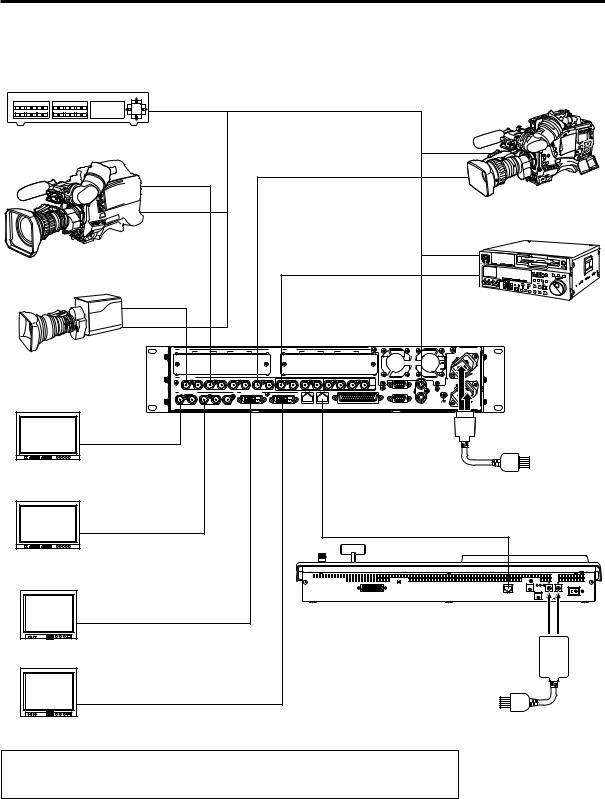
1. Installation
1-4-2. Connections when implementing gen-lock (frame synchronizer OFF)
Sync Generator
HD camera
HD camera |
HD SDI |
|
HD SDI |
|
|
|
|
|
|
|
|
|
|
|
|
|
|
|
|
|
|
|
|
|
|
|
|
|
|
|
|
|
|
|
|
|
|
|
|
|
|
|
|
|
|
|
|
|
|
VTR |
|
|
|
|
|
|
|
|
|
|
|
|
|
|
|
|
|
|
|
|
|
HD SDI |
|
|
|
|
|
|
|
|||
HD camera |
HD SDI |
|
|
|
|
|
|
|
|
|
|
|
|
|
|
|
|
|
|
|
|
|
|
|
|
|
|
SLOT A |
IN/OUT A1 |
|
IN/OUT A2 |
|
|
|
SLOT B |
IN/OUT B1 |
|
IN/OUT B2 |
|
|
|
|
|
|
|
|
|
|
|
||||
|
|
|
|
|
|
|
|
|
|
|
|
|
|
|
|
|
|
|
||||||||
|
|
|
|
|
|
|
|
|
|
|
|
|
|
|
|
|
|
|
|
|
IN1 |
|
|
|
|
|
|
SDI INPUTS |
|
|
|
|
|
|
|
|
|
|
|
|
|
|
|
|
|
|
|
|
|
|
|
|
|
|
1 |
2 |
3 |
4 |
5 |
6 |
7 |
8 |
9 |
10 |
11 |
12 |
13 |
14 |
15 |
16 |
C/C |
|
|
|
|
|
|
|
|
|
|
|
|
|
|
|
|
|
|
|
|
|
|
|
|
|
|
|
|
|
|
IN2 |
|
|
|
|
|
|
|
|
|
|
|
|
|
|
|
|
|
|
|
|
|
|
U/C |
|
|
|
SIGNAL |
|
|
|
|
|
|
SDI OUTPUTS |
|
|
|
|
DVI-D OUTPUTS |
|
|
|
|
|
|
|
|
|
|
EDITOR |
REF |
GND |
|
|
|
|
|
||
|
1 |
2 |
3 |
4 |
|
|
5 |
|
|
6 |
|
|
|
|
|
|
|
|
|
|
|
|
|
|
|
|
|
|
|
|
|
|
|
|
|
|
|
LAN |
|
PANEL |
|
TALLY/GPI |
|
|
COM |
|
|
|
|
|
|
|
|
|
HD SDI |
|
|
|
|
|
|
|
|
|
|
|
|
Multi-format Live |
|
|
|
|
|
|
||||||
|
|
|
|
|
|
|
|
|
|
|
|
|
Switcher |
|
|
|
|
|
|
|
|
|
||||
|
|
|
|
|
|
|
|
|
|
|
|
|
|
|
|
|
|
|
|
|
|
|
||||
|
|
|
|
|
|
|
|
|
|
|
|
|
|
AV-HS450N |
|
|
|
|
|
|
|
|
||||
HD SDI monitor |
|
|
|
|
|
|
|
|
|
|
|
|
|
|
|
|
|
|
|
|
|
|
|
|
|
|
|
|
|
|
|
|
|
|
|
|
|
|
|
|
|
|
|
|
|
|
|
Power cord |
|
|
|
|
|
|
HD SDI |
|
|
|
|
|
|
|
|
|
|
|
|
|
|
|
|
|
|
|
|
|
|
|
|
|
HD SDI monitor |
|
|
|
|
|
|
|
|
|
|
|
|
|
|
|
|
|
|
|
|
|
|
|
|
|
|
|
|
|
|
|
|
|
|
|
|
|
|
|
|
|
|
|
|
|
|
|
LCD CONTRAST |
|
|
|
|
|
|
|
|
|
|
|
|
|
|
|
|
|
|
|
|
|
|
TALLY / GPI |
SERVICE |
NORMAL |
|
MAINFRAME |
12V |
IN 1 |
12V |
IN 2 |
POWER |
|
|
|
|
|
|
|
|
|
|
|
|
|
|
|
|
|
|
|
|
|
|
|
|
|
|
ON OFF |
|
|
|
|
|
|
|
|
|
|
|
|
|
|
|
|
|
|
|
|
|
|
SIGNAL |
|
|
|
|
|
|
|
|
|
|
|
|
|
|
|
|
|
|
|
|
|
|
|
|
|
|
|
GND |
|
|
|
|
DVI-D |
|
|
|
|
|
|
|
|
|
|
|
|
|
|
|
|
|
|
|
|
|
|
|
|
|
PC monitor |
|
|
|
|
|
|
|
|
|
|
|
|
|
|
|
|
|
|
|
|
AC adapter |
|
|
|
|
|
|
|
|
|
|
|
|
|
|
|
|
|
|
|
|
|
|
|
|
|
|
|
|
|
|
|
|
DVI-D
PC monitor
When the unit is to be installed and when the connections are to be performed, be absolutely sure to ask your dealer to be responsible for carrying out the work that needs to be done.
Use a 3-point power outlet as the power source in order to earth the unit securely.
17

1. Installation
1-4-3. Connections when not implementing gen-lock (frame synchronizer ON)
Example where the optional board is used
SLOT A: Analog Input Board (AV-HS04M2)
SLOT B: Full-HD DVI Input Board (AV-HS04M8)
|
|
|
|
|
|
|
|
|
|
|
|
|
|
|
|
|
|
|
|
|
|
PC |
|
|
|
|
|
|
HD Component |
|
|
|
|
|
|
|
|
|
|
|
|
|
|
|
|
|
|
|
|
|
|
|
|
|
|
|
|
|
|
|
|
|
|
|
|
|
|
|
|
|
|
DVI-D |
|
|
|
|
|
PC |
|
||||
|
|
|
|
|
|
|
|
|
|
|
|
|
|
|
|
|
|
|
|
|
|
|
|
|
|||
HD camera |
|
|
|
|
|
|
|
|
|
|
|
|
|
|
|
|
|
|
|
|
|
|
|
|
|
|
|
|
HD Component |
|
|
|
|
|
|
|
|
|
|
|
|
|
|
|
|
|
|
|
DVI-D |
|
|
|
|
|
|
|
|
|
|
|
|
|
|
|
|
|
|
|
|
|
|
|
|
|
|
|
|
|
|
|
|
|
|
DVD player |
|
|
|
|
|
|
|
|
|
|
|
|
|
|
|
|
|
|
|
|
|
|
|
|
|
|
|
|
|
|
|
|
|
|
|
|
|
|
|
|
|
|
|
|
|
|
|
|
|
VTR |
|
|
|
|
|
|
HD SDI |
|
|
|
|
|
|
|
|
|
|
|
|
|
|
|
|
|
|
|
|
SD SDI |
|
|
|
|
|
|
|
|
|
|
|
|
|
|
|
|
|
|
|
|
|
|
|
|
|
|
|
|
|
|
|
|
|
|
SLOT A |
IN/OUT A1 |
|
|
IN/OUT A2 |
|
|
|
SLOT B |
IN/OUT B1 |
|
IN/OUT B2 |
|
|
|
|
|
|
|
|
|
|
|
||||
|
|
|
|
|
|
|
|
|
|
|
|
|
|
|
|
|
|
|
|
||||||||
HD camera |
|
|
|
ANALOG INPUTS |
|
|
|
|
|
|
|
|
DVI INPUTS |
|
|
|
|
|
|
IN1 |
|
|
|
|
|
||
Y |
Pb |
|
Pr |
Y |
Pb |
|
Pr |
|
|
|
DVI-D |
|
|
|
DVI-D |
|
|
|
|
|
|
|
|
|
|
||
|
|
|
|
|
|
|
|
|
|
|
|
|
|
|
|
|
|
|
|
|
|
|
|
|
|
|
|
|
SDI INPUTS |
|
|
|
|
|
|
|
|
|
|
|
|
|
|
|
|
|
|
|
|
|
|
|
|
|
|
|
1 |
2 |
3 |
|
4 |
5 |
6 |
7 |
8 |
9 |
10 |
11 |
12 |
13 |
14 |
15 |
16 |
C/C |
|
|
|
|
|
|
|
|
|
|
|
|
|
|
|
|
|
|
|
|
|
|
|
|
|
|
|
|
|
|
|
IN2 |
|
|
|
|
|
|
|
|
|
|
|
|
|
|
|
|
|
|
|
|
|
|
|
U/C |
|
|
|
SIGNAL |
|
|
|
|
|
|
SDI OUTPUTS |
|
|
|
|
|
DVI-D OUTPUTS |
|
|
|
|
|
|
|
|
|
|
EDITOR |
REF |
GND |
|
|
|
|
|
||
|
1 |
2 |
|
3 |
4 |
|
|
5 |
|
|
6 |
|
|
|
|
|
|
|
|
|
|
|
|
|
|
|
|
|
|
|
|
|
|
|
|
|
|
|
|
LAN |
|
PANEL |
|
TALLY/GPI |
|
COM |
|
|
|
|
|
|
|
||
HD SDI |
|
|
|
|
|
|
|
|
|
|
|
|
|
|
Multi-format Live |
|
|
|
|
|
|
||||||
|
|
|
|
|
|
|
|
|
|
|
|
|
|
Switcher |
|
|
|
|
|
|
|
|
|
||||
|
|
|
|
|
|
|
|
|
|
|
|
|
|
|
AV-HS450N |
|
|
|
|
|
|
|
|
||||
HD SDI monitor |
|
|
|
|
|
|
|
|
|
|
|
|
|
|
|
|
|
|
|
|
|
|
|
|
|
|
|
|
|
|
|
|
|
|
|
|
|
|
|
|
|
|
|
|
|
|
|
|
|
Power cord |
|
|
|
|
|
HD SDI |
|
|
|
|
|
|
|
|
|
|
|
|
|
|
|
|
|
|
|
|
|
|
|
|
|
|
|
HD SDI monitor |
|
|
|
|
|
|
|
|
|
|
|
|
|
|
|
|
|
|
|
|
|
LCD CONTRAST |
|
|
|
|
|
|
|
|
|
|
|
|
|
|
|
|
|
|
|
|
|
|
TALLY / GPI |
SERVICE |
NORMAL |
|
MAINFRAME |
12V |
IN 1 |
12V |
IN 2 |
POWER |
|
|
|
|
|
|
|
|
|
|
|
|
|
|
|
|
|
|
|
|
|
|
|
|
|
|
|
|
ON OFF |
|
|
|
|
|
|
|
|
|
|
|
|
|
|
|
|
|
|
|
|
|
|
|
SIGNAL |
|
|
|
|
|
|
|
|
|
|
|
|
|
|
|
|
|
|
|
|
|
|
|
|
|
|
|
|
GND |
|
|
|
DVI-D |
|
|
|
|
|
|
|
|
|
|
|
|
|
|
|
|
|
|
|
|
|
|
|
|
|
|
|
|
|
|
|
|
|
|
|
|
|
|
|
|
|
|
|
|
|
|
|
|
|
AC adapter |
|
|
|
|
|
PC monitor |
|
|
|
|
|
|
|
|
|
|
|
|
|
|
|
|
|
|
|
|
|
|
|
|
|
|
|
DVI-D
PC monitor
18
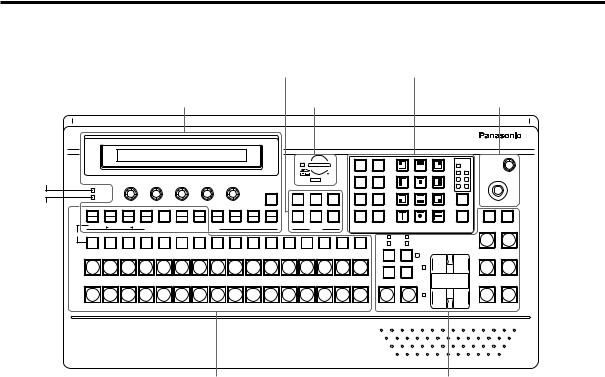
2. Functions in each area
2-1. Control panel
User button area |
|
Wipe pattern/memory area |
||||||
LCD menu area |
SD memory card area |
|
|
|
Positioner area |
|||
|
|
|
|
|
|
|
Multi-format Live Switcher AV-HS450 |
|
|
SHOT |
|
|
1 |
2 |
3 |
PAGE |
|
|
STOR |
|
|
|||||
|
MEM |
|
|
|
|
|
||
|
|
|
|
|
|
WIPE |
|
|
|
|
|
|
|
|
|
|
|
|
|
|
|
1 |
2 |
3 |
SQ1 |
Z |
BKGD |
|
|
|
|
|
SQ2 |
||
RE |
|
|
|
|
|
|
||
WIPE |
CALL |
|
4 |
5 |
6 |
SL1 |
SL2 |
|
|
MEM |
|
|
|
|
|
|
|
POWER |
|
|
|
4 |
5 |
6 |
3D1 |
3D2 |
ALARM |
|
|
|
|
|
|
|
HOLD |
|
PinP |
DEL |
|
|
|
BKGD |
|
|
|
|
|
|
|
|
|
|
|
|
|
MEM |
7 |
8 |
9 |
PATT |
|
|
||
|
|
F1 |
F2 |
F3 |
|
F4 |
F5 |
|
|
|
|
POSITIONER |
||||||
|
|
|
|
|
|
|
|
|
|
|
|
|||||||
|
|
|
|
|
|
|
|
1 |
2 |
3 |
|
7 |
8 |
9 |
|
|
|
|
KEY |
PinP1 |
DSK1 |
TIME |
IMAGE A |
FMEM |
CTL |
XPT |
IN |
CONFIG |
|
CAM |
UNDO |
10 |
11 |
12 |
KEY |
N/R |
R |
CKEY |
PinP2 |
DSK2 |
CBGD |
BKGD |
SDCard |
CAM |
MV |
OUT |
SYS |
|
MEM |
PATT |
||||||
IMAGE B |
|
|
|
|
|
|
|
|||||||||||
KEY |
PinP 1/2 |
DSK 1/2 |
AUX1 |
AUX2 |
AUX3 |
AUX4 |
|
|
|
|
4 |
|
5 |
6 |
|
|
10 |
XPT DSBL EFF DSLV |
WIPE DIRECTION |
|
|
AMBER:1 / GREEN :2 |
MENU FUNCTION / AUX BUS DELEGATION |
|
|
|
|
USER |
|
|
|
MEMORY / PATTERN |
|
|
|||||||
|
|
|
|
|
|
|
|
|
|
|
|
|||||||||
AUX |
|
|
|
|
|
|
|
|
|
|
|
|
|
|
|
|
MIX |
|
|
|
|
|
|
|
|
|
|
|
|
|
|
|
|
|
|
|
|
|
KEY |
FTB |
|
|
|
|
|
|
|
|
|
|
|
|
|
|
|
|
|
|
|
|
||
|
|
|
|
|
|
|
|
|
|
|
|
|
|
|
SHIFT |
|
WIPE |
|
ON |
ON |
|
|
|
|
|
|
|
|
|
|
|
|
|
|
|
|
BKGD |
KEY |
|
|
|
|
|
|
|
|
|
|
|
|
|
|
|
|
|
|
|
|
|
ON |
|
|
PGM/A |
|
|
|
|
|
|
|
|
|
|
|
|
|
|
SHIFT |
|
|
|
PinP1 |
PinP2 |
|
|
|
|
|
|
|
|
|
|
|
|
|
|
|
|
|
ON |
ON |
||
|
|
|
|
|
|
|
|
|
|
|
|
|
|
|
|
MIX |
WIPE |
|
||
|
|
|
|
|
|
|
|
|
|
|
|
|
|
|
|
|
|
|
||
1/17 |
2/18 |
3/19 |
4/20 |
5/21 |
6/22 |
7/23 |
8/24 |
9/25 |
10/26 |
11/27 |
12/28 |
13/29 |
14/30 |
15/31 |
16/32 |
|
|
|
|
|
PST/B |
|
|
|
|
|
|
|
|
|
|
|
|
|
|
SHIFT |
CUT |
AUTO |
DSK1 |
DSK2 |
|
|
|
|
|
|
|
|
|
|
|
|
|
|
|
ON |
ON |
|||||
|
|
|
|
|
|
|
|
|
|
|
|
|
|
|
|
|
|
|
||
Crosspoint area |
Transition area |
Power indicator [POWER]
This indicator lights when the power switch ( ) on the rear panel is set to ON while power is supplied to the DC power input socket.
It goes off when the power switch ( ) is set to OFF.
Alarm indicator [ALARM]
This indicator lights when the mainframe’s cooling fan has stopped running or when there is a problem (voltage drop) with the power supply of the mainframe or the control panel.
When this occurs, an alarm message is displayed on the LCD and on the OSD screen of the external monitor. During the occurrence of an alarm, details of the trouble can be checked using the SYSTEM/Alarm menu. Alarm information can be output to an external device from the control panel’s TALLY/GPI connector ( ).
For details, refer to “5-8-2. Alarm message”.
If the alarm goes off, stop using the unit immediately and be sure to contact your dealer. Continuing to use the unit even after the alarm goes off could damage it.
19

2. Functions in each area
2-1-1. Crosspoint area
|
|
|
|
|
|
|
|
|
|
|
1 |
|
2 |
3 |
|
KEY |
PinP1 |
DSK1 |
TIME |
BKGD |
IMAGE A |
FMEM |
CTL |
XPT |
IN |
CONFIG |
|
|
|
|
CAM |
CKEY |
PinP2 |
DSK2 |
CBGD |
IMAGE B |
SDCard |
CAM |
MV |
OUT |
SYS |
|
|
|
|
MEM |
|
|
|
|
|
|
|||||||||||
KEY |
PinP 1/2 |
DSK 1/2 |
AUX1 |
AUX2 |
AUX3 |
AUX4 |
|
|
|
|
4 |
|
5 |
6 |
|
|
AMBER:1 / GREEN :2 |
MENU FUNCTION / AUX BUS DELEGATION |
|
|
|
|
USER |
|
|
||||||
|
|
|
|
|
|
|
|
|
|||||||
AUX |
|
|
|
|
|
|
|
|
|
|
|
|
|
|
|
|
|
|
|
|
|
|
|
|
|
|
|
|
|
|
SHIFT |
PGM/A |
|
|
|
|
|
|
|
|
|
|
|
|
|
|
SHIFT |
1/17 |
2/18 |
3/19 |
4/20 |
5/21 |
6/22 |
7/23 |
8/24 |
9/25 |
10/26 |
11/27 |
12/28 |
13/29 |
14/30 |
15/31 |
16/32 |
PST/B |
|
|
|
|
|
|
|
|
|
|
|
|
|
|
SHIFT |
PGM/A bus crosspoint buttons [PGM/A 1 to 32]
These are used to select the PGM/A bus video signals.
Buttons 1 to 32 can be selected using the [SHIFT] button.
Refer to “3-1-2. Selecting the bus using the SHIFT function”.
In the case of the flip-flop system, the main line video (PGM) signals are always selected.
When one of the crosspoint buttons ( , , ) is held down, the name of the input material and the number of the crosspoint button are displayed.
PST/B bus crosspoint buttons [PST/B 1 to 32]
These are used to select the PST/B bus video signals. Buttons 1 to 32 can be selected using the [SHIFT] button.
Refer to “3-1-2. Selecting the bus using the SHIFT function”.
In the case of the flip-flop system, the images inserted next (PST) are always selected.
AUX bus selector buttons [KEY, PinP 1/2, DSK 1/2, AUX1 to AUX4]
Select the bus to be operated using the AUX bus crosspoint buttons ( ). The selected button lights.
[KEY]:
This button is used to change the AUX bus crosspoint buttons ( ) into the selector buttons for the sources of the key fill buses.
The source for the key source bus can be set using the menu displayed when the AUX bus crosspoint buttons ( ) are held down. The set source will be the same for DSK1 and DSK2.
The source can also be set from the CONFIG menu.
[PinP 1/2]:
This button is used to change the AUX bus crosspoint buttons ( ) into the selector buttons for the sources of the PinP buses.
Each time it is pressed, its target is switched between PinP1 and PinP2.
When PinP1 is selected, the button lights in amber; when PinP2 is selected, it lights in green.
[DSK 1/2]:
This button is used to change the AUX bus crosspoint buttons ( ) into the selector buttons for the sources of the DSK fill buses.
Each time it is pressed, its target is switched between DSK1 and DSK2.
When DSK1 is selected, the button lights in amber; when DSK2 is selected, it lights in green.
[AUX1] - [AUX4]:
These buttons are used to change the AUX bus crosspoint buttons ( ) into the selector buttons for the sources of the AUX buses.
The AUX bus selector buttons are also used as the menu function buttons ( ).
20

2.Functions in each area
AUX bus crosspoint buttons
These buttons are used to select the source of the bus which was selected by the AUX bus selector button ( ). Buttons 1 to 32 can be selected using the [SHIFT] button.
Refer to “3-1-2. Selecting the bus using the SHIFT function”.
2-1-2. Wipe pattern/memory area
Wipe pattern and memory selector buttons
Wipe patterns 1 to 12 can be selected while the BKGD and KEY pattern selector buttons ( ) are lighted.
Data can be stored in the memories of buttons 1 to 10 or recalled from these memories while one of the memory operation buttons ( ) — [SHOT MEM], [BKGD WIPE MEM], [PinP MEM] or [CAM MEM] — is lighted.
SHOT STOR MEM
BKGD |
RE |
|
WIPE |
||
CALL |
||
MEM |
||
|
||
PinP |
DEL |
|
MEM |
||
|
||
CAM |
UNDO |
|
MEM |
||
|
1 |
2 |
3 |
PAGE |
||
|
|
||||
|
|
|
WIPE |
|
|
1 |
2 |
3 |
SQ1 |
SQ2 |
|
|
|
|
|||
4 |
5 |
6 |
SL1 |
SL2 |
|
|
|
|
|||
4 |
5 |
6 |
3D1 |
3D2 |
|
|
|
|
BKGD |
||
7 |
8 |
9 |
PATT |
||
7 |
8 |
9 |
|
|
|
10 |
11 |
12 |
KEY |
||
PATT |
|||||
|
|
|
|||
10 XPT DSBL EFF DSLV
MEMORY / PATTERN
BKGD, KEY pattern selector buttons [BKGD PATT] [KEY PATT]
Press the [BKGD PATT] button, and while it is lighted, select the wipe pattern for the background transition. Similarly, press the [KEY PATT] button, and while it is lighted, select the wipe pattern for the key transition. Each time the [BKGD PATT] button and [KEY PATT] button are pressed, the pattern page changes in the following sequence: WIPE, SQ1 (squeeze 1), SL1 (slide 1), 3D1 (3 dimensions 1), SQ2 (squeeze 2), SL2 (slide 2) and 3D2 (3 dimensions 2). Which pattern page has been selected can be checked by observing which pattern page indicator LED ( ) is lighted.
SQ2, SL2, and 3D2 may not be selected as the wipe pattern for the key transition.
Pattern page indicator LEDs [PAGE]
By observing which pattern page indicator LED is lighted, it is possible to check which pattern page has been selected by the BKDG PATT or KEY PATT selector button ( ).
Memory operation buttons [SHOT MEM] [BKGD WIPE MEM] [PinP MEM] [CAM MEM] [STOR] [RECALL] [DEL] [UNDO]
Press the [SHOT MEM], [BKGD WIPE MEM], [PinP MEM] or [CAM MEM] button to perform the memory operations for the number keys (1 to 10).
[STOR]:
Press this to register data in the memory.
[RECALL]:
Press this to recall data from the memory.
[DEL]:
Press this to delete data in the memory.
[UNDO]:
Press this to undo the operation of the [RECALL] or [DEL] button. The number of operations that can be undone is one only.
This operation cannot be performed using memory operations when the [CAM MEM] button has been pressed.
21
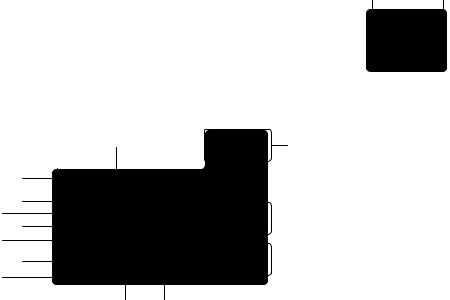
2. Functions in each area
2-1-3. User button area |
|
|
|
|
|
|
|
|
User buttons [USER1 to USER6]
These are used to assign some functions of the menu settings to the [USER1] to [USER6] buttons on the CONFIG menu.
See “5-3-1. Setting the user buttons”.
1 |
2 |
3 |
4 |
5 |
6 |
USER
2-1-4. Transition area
UNDO |
10 |
11 |
12 |
KEY |
N/R |
R |
PATT |
||||||
|
10 |
XPT DSBL |
EFF DSLV |
|
WIPE DIRECTION |
|
|
|
|
|
|
||
MEMORY / PATTERN
|
MIX |
|
KEY |
FTB |
|
WIPE |
ON |
ON |
|||
|
BKGD |
KEY |
|
|
|
|
|
ON |
|
|
|
|
|
PinP1 |
PinP2 |
||
|
MIX |
WIPE |
ON |
ON |
|
|
|
|
|
|
|
|
CUT |
AUTO |
DSK1 |
DSK2 |
|
ON |
ON |
||||
|
|






[BKGD] button
This executes the background transition when the [AUTO] button ( ) or fader lever ( ) has been operated. When the [BKGD] button is pressed and it is selected, its indicator lights in amber.
If the [KEY] button ( ) is now pressed, the indicator goes off, and the de-selected status is established. When the [BKGD] button and [KEY] button ( ) are pressed at the same time, both buttons are set to the selected status.
[KEY] button
This executes the key transition when the [AUTO] button ( ) or fader lever ( ) has been operated. When the [KEY] button is pressed and it is selected, its indicator lights in amber.
If the [BKGD] button ( ) is now pressed, the indicator goes off, and the de-selected status is established. When the [BKGD] button ( ) and [KEY] button are pressed at the same time, both buttons are set to the selected status.
KEY ON tally LED
This lights in red when the key ON status is established.
MIX, WIPE selection status tally LEDs
These light up to indicate whether MIX or WIPE has been selected when background transitions or key transitions are executed.
22

2.Functions in each area
[MIX] button
This is used to switch the A and B bus images while making them overlap. During the transition, the A and B bus output total is kept at 100 %.
When the [MIX] button is pressed and it is selected, its indicator lights in amber.
If the [WIPE] button ( ) is now pressed, it goes off, and the de-selected status is established.
[WIPE] button
This is used to execute the transition using the pattern selected by the wipe pattern selector button ( ). When the [WIPE] button is pressed and it is selected, its indicator lights in amber.
If the [MIX] button ( ) is now pressed, it goes off, and the de-selected status is established.
[AUTO] button
This is used to automatically execute transitions (auto transition) using the transition time which has been set on the TIME menu.
During auto transition its indicator lights in amber. When the button is pressed again during auto transition, the auto transition operation is suspended, and the indicator lights in green. When it is pressed again while auto transition is suspended, the remaining transition is executed.
The indicator goes off when auto transition is completed.
When the [AUTO] button is pressed while the fader lever ( ) is at an interim setting, the transition is executed in the time remaining from the interim setting.
[CUT] button
This button is used to execute transitions instantly.
Its indicator lights in amber during a transition, and it goes off when the transition is completed.
[KEY ON] button
This button is used to execute the key transition for the transition time which has been set on the TIME menu.
[FTB ON] button
This button is used to execute fade-out to a black screen or fade-in from a black screen for the transition time which has been set on the TIME menu.
PinP button [PinP1 ON] [PinP2 ON]
This button is used to execute fade-in or fade-out of the picture in picture for the transition time which has been set on the TIME menu.
DSK button [DSK1 ON] [DSK2 ON]
This button is used to execute fade-in or fade-out of downstream key for the transition time which has been set on the TIME menu.
23

2.Functions in each area
Wipe direction selection buttons [WIPE DIRECTION N/R, R]
These buttons are used to select the direction in which to wipe for executing background transitions.
When the [R] indicator is off:
Wiping proceeds in the normal direction.
When the [R] indicator is lighted:
Wiping proceeds in the reverse direction.
When the [N/R] indicator is lighted:
The normal direction is replaced with the reverse direction (or vice versa) when the transition is completed. (The lighted and extinguished statuses of the [R] button are also switched in line with the direction of the wiping.)
Fader lever
This is used to execute background or key transitions. When it is moved as far as it will go, the transition is completed. When it has been operated during auto transition, auto transition will be switched to manual operation as soon as the fader position overtakes the amount of the transition being executed.
Bus tally LEDs
These indicate the output statuses of the A bus and B bus. The LED corresponding to the bus whose program signals (PGM) are being output lights.
24

2. Functions in each area
2-1-5. LCD menu area
|
POWER |
|
|
|
|
|
|
|
|
|
|
|
ALARM |
|
|
|
|
|
|
|
|
HOLD |
|
||
|
|
|
|
|
|
|
|
|
||||
|
|
|
|
|
|
|
|
|
|
|
|
|
|
|
|
F1 |
|
F2 |
F3 |
|
F4 |
F5 |
|
|
|
|
KEY |
PinP1 |
DSK1 |
TIME |
BKGD |
IMAGE A |
FMEM |
CTL |
XPT |
IN |
CONFIG |
|
|
CKEY |
PinP2 |
DSK2 |
CBGD |
IMAGE B |
SDCard |
CAM |
MV |
OUT |
SYS |
|
|
|
|
|||||||||||
|
KEY |
PinP 1/2 |
DSK 1/2 |
AUX1 |
AUX2 |
AUX3 |
AUX4 |
|
|
|
|
|
 AMBER:1 / GREEN :2
AMBER:1 / GREEN :2 
MENU FUNCTION / AUX BUS DELEGATION
LCD
The setting menu is displayed when one of the menu function buttons ( ) is pressed.
When the buttons listed below are double-clicked, the specified menu is selected. (The menu delegation function)
The operation corresponding to the button pressed is also executed.
<List of menu delegation functions>
|
Button |
Menu |
Transition area |
BKGD |
TIME menu/BKGD sub menu |
|
KEY |
TIME menu/KEY sub menu |
|
WIPE |
BKGD menu/Border sub menu |
Wipe pattern area |
WIPE #5 |
BKGD menu/WIPEPos sub menu |
|
(BKGD) |
|
|
WIPE #5 |
KEY menu/WIPEPos sub menu |
|
(KEY) |
|
|
WIPE #11 |
BKGD menu/WIPEPos sub menu |
|
(BKGD) |
|
|
WIPE #11 |
KEY menu/WIPEPos sub menu |
|
(KEY) |
|
|
SQ #5 |
BKGD menu/SQPos sub menu |
|
(BKGD) |
|
|
SQ #5 |
KEY menu/SQPos sub menu |
|
(KEY) |
|
|
SL #5 |
KEY menu/FlyKEY sub menu |
|
(KEY) |
|
25
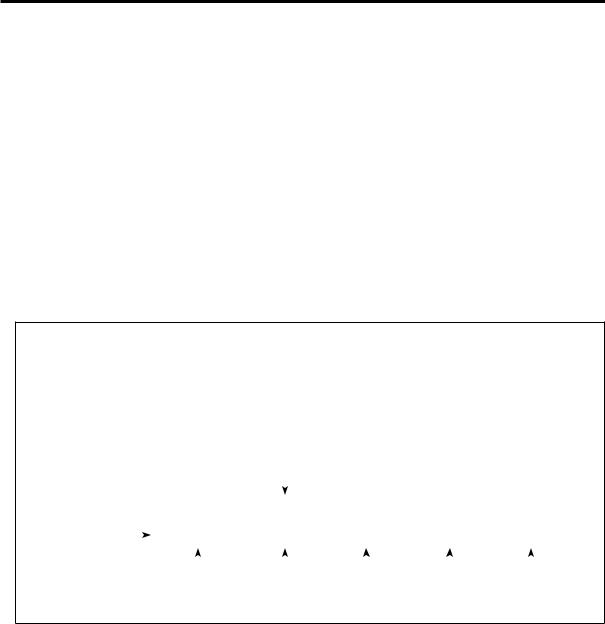
2.Functions in each area
Menu function buttons [MENU FUNCTION/AUX BUS DELEGATION]
These are used to select the menus organized by function.
Each time one of these buttons is pressed, the menu for its function is switched between the one displayed above and the one displayed below. Each time the [PinP1/PinP2] button or [DSK1/DSK2] button is pressed, the color used for their lighting is switched between amber and green. The other buttons light in amber.
Rotary encoders [F1] to [F5]
These are used to set the parameters displayed on the menus (LCD screen or on-screen display). For details on the operations, refer to the sections in “3. Basic operations”.
[F1]: Rotate this rotary encoder to switch the sub menu.
On the INPUT menu or OUTPUT menu, the signal to be set is switched. [F2]: Turn this rotary encoder to set the parameters.
On the INPUT menu or OUTPUT menu, the third menu is switched.
[F3] to [F5]: Rotate these rotary encoders to set the parameters.
When the down arrow (↓) is shown at a menu item, its parameter is set by pressing the corresponding rotary encoder.
When the parameter is one which is set using a numerical value, its default will be restored when the rotary encoder is held down.
(However, the network settings and the date and time settings will not be returned to the defaults.)
Basic menu operations
For detailed operations, refer to the sections in “3. Basic operations”.
For the menu configurations, refer to “8. Setting menu table”.
Select the menus organized by function using the menu function buttons ( ).
Using the rotary encoders ( ), display the sub menu that will be used to establish the detailed settings, and set the parameters.
|
|
|
|
|
|
|
|
|
Parameter setting area |
|
|
|
|||
|
|
|
|
|
|
|
|
|
|
|
|
|
|
|
|
|
|
|
|
|
|
|
|
|
|
|
|
|
|
|
|
|
|
|
|
|
|
|
Third menu |
|
|
|
|
|
|
|
|
|
|
|
|
|
|
|
|
|
|
|
|
|
|
||
|
|
|
|
|
|
|
|
|
|
|
|
|
|
||
|
|
|
|
|
|
|
|
|
|
|
|
|
|
|
|
|
|
|
|
|
|
|
|
|
|
|
|
|
|
|
|
|
|
|
KEY |
2|Clip |
|Gain |Density|Invert |
||||||||||
Sub menu |
|
|
Adjust |
| |
0.0| 100.0| 100.0| |
|
Off |
||||||||
|
|
||||||||||||||
|
|
|
|
|
|
|
|
|
|
|
|
|
|
||
|
|
|
|
|
|
|
|
|
|
|
|
|
|
|
|
|
|
|
Operate here |
|
|
Operate here |
|
|
Operate here |
||||||
|
|
|
using [F1]. |
|
|
Operate here |
using [F3]. |
Operate here |
using [F5]. |
||||||
|
|
|
|
|
|
|
|
|
|
|
|
||||
|
|
|
|
|
|
|
using [F2]. |
|
|
using [F4]. |
|
|
|
||
The INPUT menu and OUTPUT menu differ depending on whether an option board has been installed.
[HOLD] button
If the [HOLD] button is pressed while a menu is displayed, no other menu will be selected even when a menu function button ( ) is pressed.
In addition, even if the AUX bus selection button ( ) is pressed it will not switch to another bus. While the [HOLD] button is held down, it lights in amber.
26
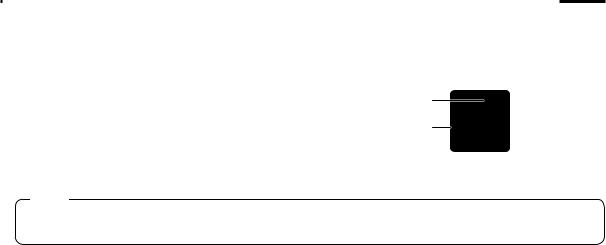
2. Functions in each area
2-1-6. Positioner area
Positioner [X/Y]
These are used when performing the settings below.
PinP1, PinP2 position settings
Wipe start position setting (WIPE #5, WIPE #11, SQ #5)
Camera control
Flying key position setting
Chroma key marker position setting
Z
POSITIONER
In each case, the settings take effect only when the following menu items have been selected.
Note
The center values of the positioner are set during the time it takes for the unit to start up after its power is turned on. Do not operate the positioner until after the switcher has started up.
Rotary encoder [Z]
This is used to set the PinP size, flying key size or to select the chroma key area.
In each case, the settings take effect only when the following menu items have been selected.
|
Positioner |
Rotary encoder |
Valid menu |
|
|
X/Y |
Z |
Switch |
|
|
|
|||
PinP1, PinP2 |
Position adjustments |
Size adjustments |
Hold switch down to |
All PinP1 and PinP2 |
|
|
(size increased by rotating |
restore initial values |
menus (except for |
|
|
the encoder clockwise |
(X/Y, Z). |
PinP1, PinP2/Rotation) |
|
|
and reduced by rotating it |
|
|
|
|
counterclockwise) |
|
|
|
Rotation angle |
Rotation angle |
Hold switch down to |
PinP1, PinP2/ |
|
adjustments |
adjustments |
restore initial values |
Rotation |
|
(X-direction and |
(Z-direction rotation) |
(X/Y, Z). |
|
|
Y-direction rotation) |
|
|
|
WIPE (BKGD) |
Start position |
— |
Hold switch down to |
BKGD/WIPEPos |
|
adjustments |
|
restore initial values |
BKGD/SQPos |
|
|
|
(X/Y). |
|
WIPE (KEY) |
Start position |
— |
Hold switch down to |
KEY/WIPEPos |
|
adjustments |
|
restore initial values |
KEY/SQPos |
|
|
|
(X/Y). |
|
Chroma key |
Selection position |
Selected area size |
Execute sampling |
CHR KEY/Sample1 |
|
adjustments |
adjustments |
|
CHR KEY/Sample2 |
|
|
(size increased by rotating |
|
|
|
|
the encoder clockwise |
|
|
|
|
and reduced by rotating it |
|
|
|
|
counterclockwise) |
|
|
Flying key |
Position adjustments |
Size adjustments |
Hold switch down to |
KEY/FlyKEY |
|
|
(size increased by rotating |
restore initial values |
|
|
|
the encoder clockwise |
(X/Y, Z). |
|
|
|
and reduced by rotating it |
|
|
|
|
counterclockwise) |
|
|
Camera control |
X: Pan control or focus |
— |
Switching between |
All menus other than |
|
control |
|
pan/tilt control and |
those listed above |
|
Y: Tilt control or zoom |
|
zoom/focus control |
|
|
control |
|
|
|
|
|
|
|
|
27
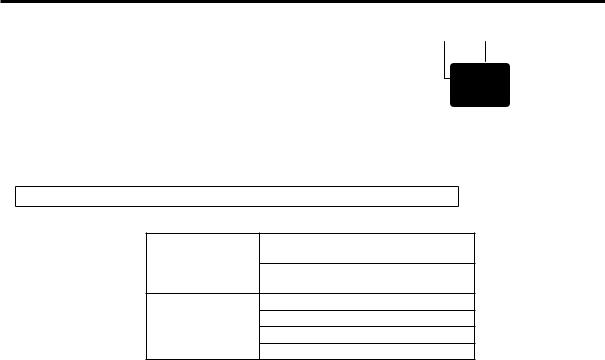
2. Functions in each area
2-1-7. SD memory card area |
|
|
SD memory card slot
Insert an SD memory card (purchased separately) or an SDHC memory card (purchased separately) into this slot.
SD memory card access LED
This LED lights while the data on the SD memory card is being accessed.
Do not turn off the unit’s power or eject the SD memory card while the access LED is lighted. Doing so can damage the data on the SD memory card.
Concerning the recommended SD memory cards and SDHC memory cards
Use of the following SD memory cards and SDHC memory cards made by Panasonic is recommended:
SDHC memory cards RP-SDM04G, RP-SDM06G, RP-SDM08G,
RP-SDM12G, RP-SDM12G
RP-SDV04G, RP-SDV08G, RP-SDV16G,
RP-SDV32G
SD memory cards RP-SD128B, RP-SD256B
RP-SDR512
RP-SDM01G, RP-SDM02G
RP-SDV512, RP-SDV01G, RP-SDV02G
28

2. Functions in each area
2-1-8. Rear panel connections area
TALLY / GPI |
SERVICE |
NORMAL |
|
|
|
LCD CONTRAST |
|
|
|
|
|
MAINFRAME |
12V |
IN 1 |
12V |
IN 2 |
POWER |
|
|
|
|
|
|
ON |
OFF |
|
SIGNAL |
|
|
|
|
|
|
|
GND |
|
|
|
|
TALLY/GPI input/output connector [TALLY/GPI] (D-sub 25-pin, female, inch screw)
For details on how to connect this connector, refer to “6. External interfaces”.
MAIN FRAME connector [MAIN FRAME] (RJ-45) (100 Base-TX)
Connect this to the mainframe using the supplied CAT5E cable (STP, straight, 10 m).
DC power input sockets [12V 

 IN1], [12V
IN1], [12V 

 IN2] (DC 12 V, 0.8 A)
IN2] (DC 12 V, 0.8 A)
Connect the supplied AC adapters (for the control panel) to these sockets.
Ground connector [SIGNAL GND]
Connect to the system’s earth ground.
Power switch [POWER]
This is used to turn the power on and off.
SERVICE switch [NORMAL/SERVICE]
This switch is used for maintenance purposes.
For normal operations, select the “NORMAL” position.
LCD CONTRAST adjustment screw
This is used to adjust the contrast of the LCD display.
29
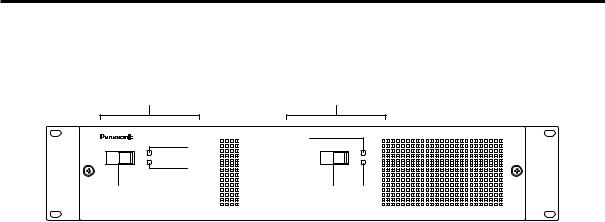
2. Functions in each area
2-2. Mainframe
2-2-1. Front panel
Power supply 1 Power supply 2
|
|
|
|
POWER1 |
POWER2 |
ON |
|
OFF ON |
OFF |
||
POWER1 |
|
POWER2 |
|
ALARM1 |
|
|
ALARM2 |
|
|
|
|
Multi-format Live Switcher AV-HS450
Power switch [POWER1, POWER2]
These are used to turn the power on and off.
As a standard feature, this mainframe has a redundant power supply system.
To turn off the power, set the power switches of both system 1 (POWER1) and system 2 (POWER2) to OFF.
Power indicator [POWER1, POWER2]
This indicator lights when the power switch ( ) is set to ON while power is supplied to the AC power input socket.
It goes off when the power switch ( ) is set to OFF.
Alarm indicator [ALARM1, ALARM2]
These light when the mainframe’s cooling fan has stopped running or when there is a problem (voltage drop) in the power supply. When this occurs, an alarm message is displayed on the control panel’s LCD and on the OSD screen of the external monitor.
During the occurrence of an alarm, details of the trouble can be checked using the SYSTEM/Alarm menu.
The alarm information can be output to an external device from the TALLY/GPI connector ( ) of the mainframe.
For details, refer to “5-8-2. Alarm message”.
If the alarm goes off, stop using the unit immediately and be sure to contact your dealer. Continuing to use the unit even after the alarm goes off could damage it.
30
